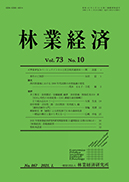All issues

Volume 73, Issue 10
FOREST ECONOMY
Displaying 1-17 of 17 articles from this issue
- |<
- <
- 1
- >
- >|
-
2021Volume 73Issue 10 Pages Cover_1
Published: 2021
Released on J-STAGE: March 01, 2021
JOURNAL FREE ACCESSDownload PDF (240K) -
2021Volume 73Issue 10 Pages Toc_1
Published: 2021
Released on J-STAGE: March 01, 2021
JOURNAL FREE ACCESSDownload PDF (240K) -
[in Japanese]2021Volume 73Issue 10 Pages i
Published: 2021
Released on J-STAGE: March 01, 2021
JOURNAL FREE ACCESSDownload PDF (254K) -
Shin NAGATA2021Volume 73Issue 10 Pages 1
Published: 2021
Released on J-STAGE: March 01, 2021
JOURNAL FREE ACCESSDownload PDF (120K) -
Momoko MOGI, Satoshi TACHIBANA2021Volume 73Issue 10 Pages 2-17
Published: 2021
Released on J-STAGE: March 01, 2021
JOURNAL FREE ACCESSPrevious research on domestic timber distribution shows a significant increase in shares of laminated timber, lumber precutting by machinery, and direct sawlog procurement by large sawmills since the mid-1990s. The aim of this study was to reveal changes in the timber distribution structure since 1990s in the Nishikawa Forestry Region in Saitama Prefecture, which has characteristics of the traditional timber distribution of sawlogs consisting of transactions on the log auction organization and with small businesses operators. Methods include a statistical data survey and interviews with regional business operators regarding the sawlog volume handled, changes in the number of sellers and buyers and in sawlog prices. The main results are as follows: at the beginning of the 1990s, there were more than 100 sawmills and 7 log auction organizations; these have recently decreased to 16 sawmills and 2 log auction organizations. Sawlog prices also declined during this period. It was found that the decrease in the number of businesses operators was affected by the decrease in demand for accessory wood products and the decrease in the number of buyers from western Japan. It was also revealed that the sawmills, which are still in operation, deals directly with builder, and the lumber precut mill produces and sells furniture and joinery in addition to lumber precutting, which is different from the traditional timber distribution.View full abstractDownload PDF (991K) -
Ikumi OTSUKA2021Volume 73Issue 10 Pages 18-21
Published: 2021
Released on J-STAGE: March 01, 2021
JOURNAL FREE ACCESSDownload PDF (320K) -
Mitsuhiro MINOWA2021Volume 73Issue 10 Pages 22-24
Published: 2021
Released on J-STAGE: March 01, 2021
JOURNAL FREE ACCESSDownload PDF (250K) -
Takuya HIROSHIMA2021Volume 73Issue 10 Pages 25-29
Published: 2021
Released on J-STAGE: March 01, 2021
JOURNAL FREE ACCESSDownload PDF (281K) -
2021Volume 73Issue 10 Pages 30
Published: 2021
Released on J-STAGE: March 01, 2021
JOURNAL FREE ACCESSDownload PDF (135K) -
2021Volume 73Issue 10 Pages 31
Published: 2021
Released on J-STAGE: March 01, 2021
JOURNAL FREE ACCESSDownload PDF (68K) -
2021Volume 73Issue 10 Pages 32
Published: 2021
Released on J-STAGE: March 01, 2021
JOURNAL FREE ACCESSDownload PDF (75K) -
2021Volume 73Issue 10 Pages ii
Published: 2021
Released on J-STAGE: March 01, 2021
JOURNAL FREE ACCESSDownload PDF (208K) -
2021Volume 73Issue 10 Pages ii
Published: 2021
Released on J-STAGE: March 01, 2021
JOURNAL FREE ACCESSDownload PDF (208K) -
2021Volume 73Issue 10 Pages ii
Published: 2021
Released on J-STAGE: March 01, 2021
JOURNAL FREE ACCESSDownload PDF (208K) -
2021Volume 73Issue 10 Pages ii
Published: 2021
Released on J-STAGE: March 01, 2021
JOURNAL FREE ACCESSDownload PDF (208K) -
2021Volume 73Issue 10 Pages Cover_2
Published: 2021
Released on J-STAGE: March 01, 2021
JOURNAL FREE ACCESSDownload PDF (92K) -
2021Volume 73Issue 10 Pages Toc_2
Published: 2021
Released on J-STAGE: March 01, 2021
JOURNAL FREE ACCESSDownload PDF (92K)
- |<
- <
- 1
- >
- >|